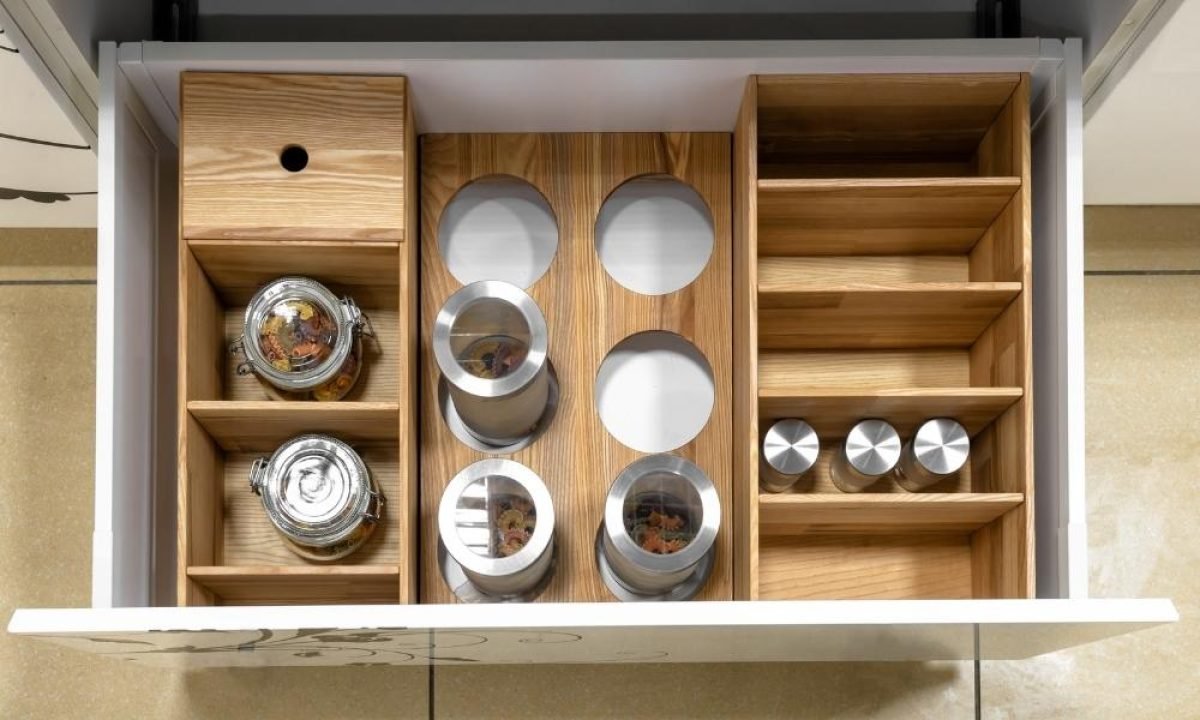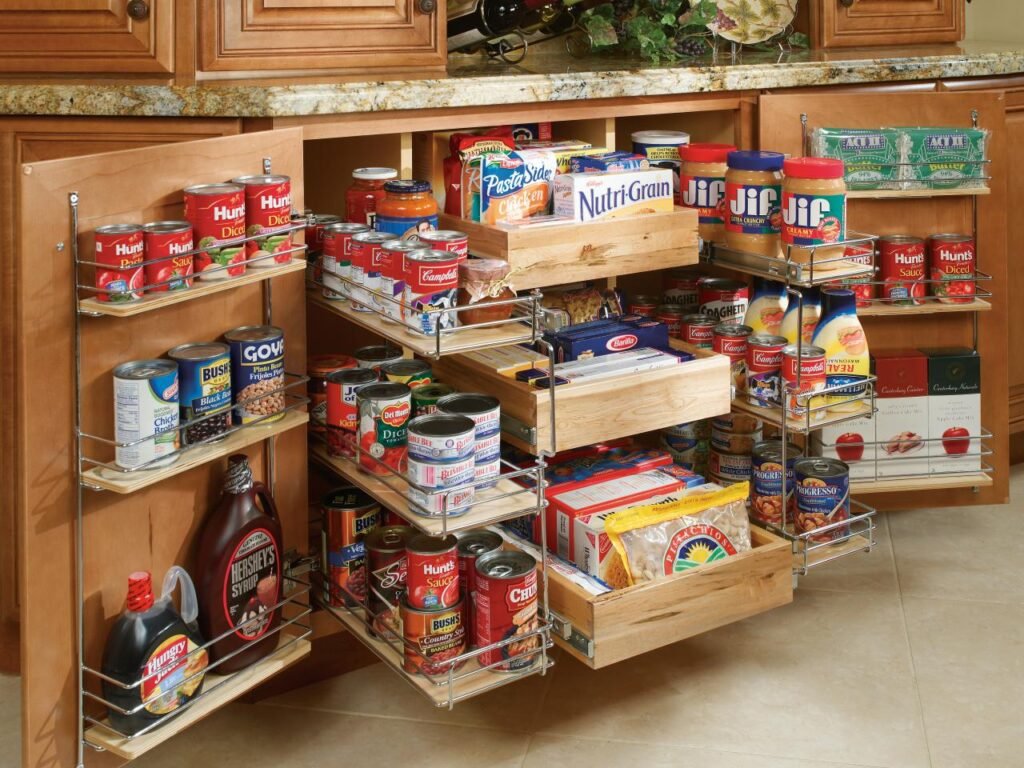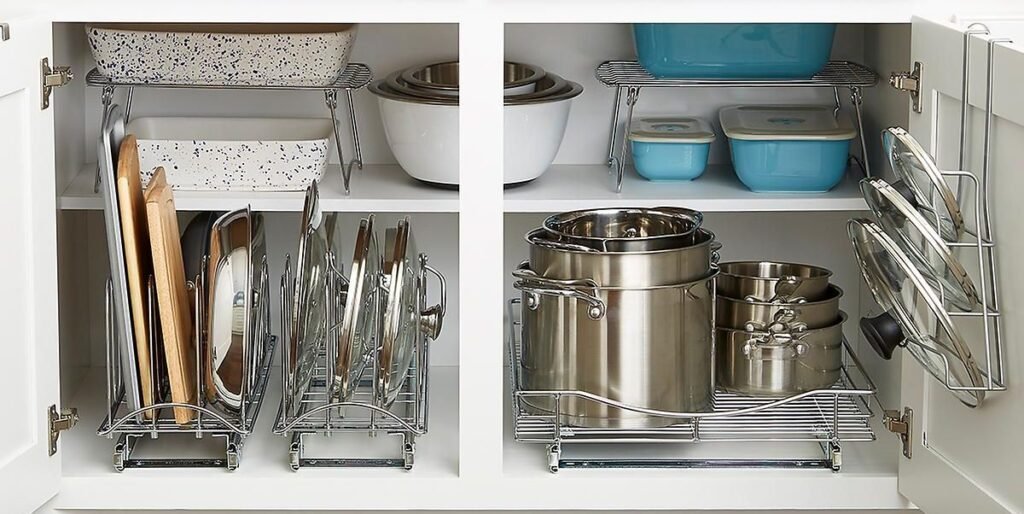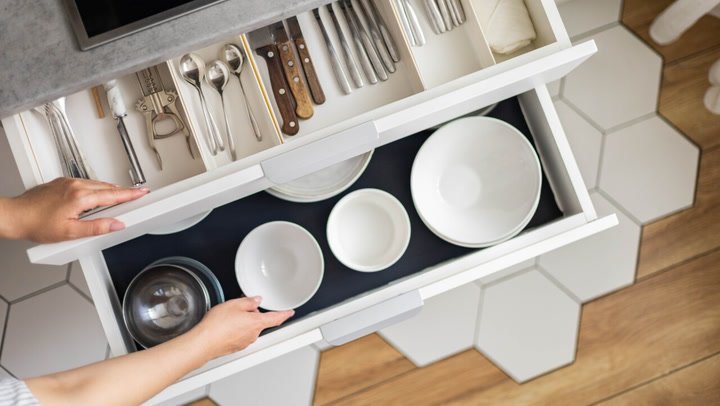
Kitchen Bliss: 5 Easy Steps to Organize Your Cabinets
Hi there! Are you tired of rummaging through cluttered kitchen cabinets to find the ingredients or utensils you need? If so, you’re not alone. Having an organized kitchen not only streamlines meal preparation but also enhances the overall functionality and efficiency of your space. In this blog post, I’ll guide you through five easy steps to help you organize your kitchen cabinets effortlessly. Get ready to create a well-organized and stress-free kitchen that will make cooking a breeze. So, let’s dive in and transform your kitchen cabinets in no time!
3 Simple Projects for Better Kitchen Storage
3 small DIY projects for better kitchen storage and organization. Kitchen cabinets and drawers can store more than you think!
10 Kitchen Organizing Ideas - Fast & Easy!
Get your Kitchen Organized for 2023 with these easy and fast kitchen organizing ideas. Give your kitchen a makeover with a little ...
Assess and declutter
Before you dive into organizing your kitchen cabinets, it’s essential to start with a solid foundation. Assessing the current state of your cabinets and decluttering any unnecessary items will set the stage for an organized and efficient space. In this blog section, we will guide you through the process of assessing and decluttering, providing you with practical tips and insights.
Assessing Your Cabinets
Assessing your kitchen cabinets involves taking inventory of what you currently have. This step is crucial in identifying items that are no longer serving a purpose or causing clutter. Here are some key points to consider during the assessment:
- Categorize your items: Group similar items together, such as cookware, dishes, glassware, and food storage containers. This categorization will help you visualize the quantity of each item and identify any duplicates or excess.
- Evaluate your usage: Consider how often you use each item. Items that haven’t been used in months or are past their expiration date should be marked for decluttering.
- Assess storage space: Take note of which items are taking up excessive space or causing disorganization. Identifying these areas will help you optimize your storage solutions later on.
Decluttering Your Cabinets
Once you have completed the assessment, it’s time to declutter your kitchen cabinets. Removing unnecessary items will create more space and streamline your daily kitchen activities. Follow these steps to effectively declutter:
- Get rid of expired or unused items: Start by disposing of any expired food products, spices, or medications. Next, identify any kitchen tools or gadgets that you haven’t used in the past year and consider donating or selling them.
- Donate or sell items: If you have duplicates or perfectly functional items that you no longer need, consider donating them to a local charity or selling them online. Not only will this help clear your cabinets, but it will also benefit others.
- Assess sentimental items: Sentimental items can quickly accumulate in our kitchen cabinets. While it’s important to hold onto those that truly hold meaning, be selective in choosing which ones to keep and find alternative storage solutions if necessary.
Benefits of Assessing and Decluttering
Taking the time to assess and declutter your kitchen cabinets offers numerous benefits that make the effort worthwhile. Here are some key advantages:
- Increased efficiency: Streamlining your cabinets means you can easily find what you need, reducing time spent searching for items during meal preparation.
- Enhanced cleanliness: Decluttered cabinets are easier to clean and maintain, promoting a hygienic kitchen environment.
- Maximized storage space: By eliminating unnecessary items, you create more room for essential kitchen tools and supplies.
- Aesthetically pleasing: Organized and decluttered cabinets make your kitchen visually appealing, contributing to a calm and inviting atmosphere.

Group similar items
When it comes to optimizing your kitchen cabinet space, one of the most effective strategies is to group similar items together. This simple step can greatly enhance the functionality and efficiency of your kitchen, making it easier to find what you need and avoid unnecessary clutter. In this blog section, we will delve into the importance of grouping similar items and provide practical tips to help you achieve a well-organized kitchen.
Why Grouping Similar Items Matters
Grouping similar items within your kitchen cabinets offers several benefits that can significantly improve your cooking experience. Consider the following advantages:
- Efficient Use of Space: By grouping similar items together, you can maximize the use of available space in your cabinets. This approach eliminates wasted space between unrelated items, allowing you to fit more into your cabinets without sacrificing accessibility.
- Easy to Find and Access: When you have a designated area for specific items, it becomes much easier to locate and access them when needed. No more rummaging through cluttered cabinets in search of that one pot or utensil – it will be right where it belongs.
- Reduced Clutter: Grouping similar items helps keep your kitchen cabinets neat and clutter-free. You won’t have to deal with stacks of mismatched pans or utensils tumbling out every time you open the cabinet doors. Instead, you’ll have a tidy and visually appealing storage solution.
How to Group Similar Items Effectively
Now that we understand the importance of grouping similar items, let’s explore some practical tips to help you implement this organizational method in your kitchen cabinets:
Categorize Your Kitchen Tools and Utensils
Create logical categories for your kitchen tools and utensils based on their functions. Consider categorizing items such as:
- Cooking utensils (e.g., spatulas, tongs)
- Mixing bowls and measuring cups
- Baking supplies (e.g., cookie cutters, piping bags)
- Cutting boards and knives
Assign Designated Areas for Each Category
Once you’ve categorized your kitchen items, allocate designated areas within your cabinets for each category. This can be achieved by using dividers, trays, or even labels to clearly differentiate different sections.
Utilize Vertical and Horizontal Space
Make the most of your cabinet space by arranging items efficiently. Stack pots and pans to save vertical space, hang mugs or measuring spoons on hooks underneath shelves, or use stackable containers for smaller items like spice jars. Utilize risers or shelf organizers to create additional levels for increased storage capacity.
Maintain a System for Easy Access
To ensure easy access to your grouped items, establish a system that works for you. Arrange frequently used items at eye level or within arm’s reach, while reserving higher or lower shelves for less frequently used items. This organization will streamline your cooking process and reduce unnecessary bending or reaching.

Utilize storage solutions
Are you tired of having limited space in your kitchen cabinets? Do you struggle to find what you need, only to have items come tumbling out when you open the door? It’s time to take control of your cabinet space and make the most of it by utilizing storage solutions. In this blog section, we will explore various tools and techniques that can help you maximize your kitchen cabinet space, prevent clutter, and create a more efficient and organized layout.
Key storage solutions
Shelf Dividers
Shelf dividers are a game-changer when it comes to organizing your kitchen cabinets. These handy tools can be easily inserted onto your shelves to create separate compartments and prevent items from falling over. Here are some key benefits of using shelf dividers:
- Maximize vertical space by stacking items without the risk of toppling over.
- Keep items neatly separated, making it easier to find what you need.
- Utilize every inch of cabinet space efficiently, preventing wasted space.
Drawer Inserts
Are your kitchen drawers cluttered and disorganized? Drawer inserts can help solve this problem. These customizable organizers can be fitted into your drawers to create designated spaces for different types of items. Here’s why you should consider using drawer inserts:
- Keep utensils, cutlery, and other small items neatly organized and easily accessible.
- Prevent items from shifting and sliding around, reducing the risk of damage.
- Maximize drawer space by creating separate compartments for different items.
Stackable Containers
Stackable containers are a fantastic solution for storing dry goods, snacks, and even kitchen tools. These containers come in various sizes and shapes, allowing you to maximize cabinet space efficiently. Consider the following benefits of using stackable containers:
- Create a neat and uniform appearance by organizing items in a stack.
- Maximize vertical space by utilizing the height of your cabinets.
- Easily identify items at a glance, thanks to transparent containers.

How to make the most of these storage solutions
Now that you know about the key storage solutions, it’s time to put them into action. Here are some tips to help you make the most of your kitchen cabinet space:
- Evaluate your items: Take stock of what you have and declutter any items you no longer need or use. This will free up valuable space and make it easier to organize your remaining items.
- Categorize and group similar items: Arrange your items into categories such as utensils, plates, cups, etc. This will help you determine the storage solutions you need and create a more organized layout.
- Measure your cabinets: Before purchasing any storage solutions, measure your cabinet dimensions to ensure a proper fit. This will prevent you from buying items that are too big or small for your cabinets.
- Utilize vertical space: Make use of tall cabinets by stacking items vertically. Consider using shelf dividers and stackable containers to maximize the available height.
- Customize your storage: Invest in adjustable shelf dividers and customizable drawer inserts to cater to your specific needs. This will allow you to create compartments of various sizes to accommodate different items.
Comparison Table: Key Features of Storage Solutions
To help you understand the benefits of each storage solution at a glance, here’s a comparison table:
| Storage Solution | Key Features |
|---|---|
| Shelf Dividers | – Maximize vertical space- Prevent items from toppling over- Create separate compartments |
| Drawer Inserts | – Keep items organized- Prevent shifting and sliding- Maximize drawer space |
| Stackable Containers | – Utilize vertical space efficiently- Create a uniform appearance- Easy identification of items |
In conclusion, utilizing storage solutions such as shelf dividers, drawer inserts, and stackable containers can make all the difference in optimizing your kitchen cabinet space. By implementing these tools and techniques, you’ll be amazed at how much more organized and efficient your kitchen will become. Say goodbye to clutter and hello to a well-arranged and functional kitchen!
Labeling your Kitchen Cabinets: Improving Visibility and Accessibility
The Importance of Labeling
Labeling your kitchen cabinets can be a game-changer when it comes to organizing your space and saving time. It not only enhances the visibility of your stored items but also makes it easier to find and retrieve what you need. By implementing simple labeling techniques, you can streamline your kitchen workflow and maintain order effortlessly.
Choose the Right Labels
When it comes to labeling your kitchen cabinets, there are various options to consider. Here are two popular choices:
- Adhesive Labels: These labels are easy to use and apply to any surface. They can be printed or handwritten, allowing you to customize each label according to the contents of your cabinets. Adhesive labels are available in various sizes and designs, allowing you to match them to your kitchen décor.
- Chalkboard Stickers: Chalkboard stickers offer a stylish and flexible labeling solution. They allow you to modify labels as needed by simply erasing and rewriting. Chalkboard stickers can be cut into different shapes and sizes, making them versatile for any cabinet configuration.
Benefits of Labeling
Labeling your kitchen cabinets brings several benefits that can positively impact your daily routine. Here are a few key advantages:
- Improved Organization: By categorizing items and assigning them a designated space, you can quickly locate what you need and avoid unnecessary searching or clutter.
- Efficient Workflow: With clear labels, you can establish an efficient workflow in your kitchen. Whether you’re cooking a meal or baking, having ingredients and tools readily accessible reduces preparation time and enhances productivity.
- Reduced Waste: Proper labeling allows you to see and track the contents of your cabinets, preventing you from purchasing unnecessary duplicates or forgetting about items that may expire.

Maintaining Organized Cabinets
Labeling your cabinets is just the beginning; maintaining organization is equally important. Here are a few tips to keep your cabinets clutter-free:
- Regular Cleaning: Schedule regular cleaning sessions to remove any dust or spills that may accumulate over time. Wipe down the shelves, remove expired products, and reorganize as necessary.
- Decluttering: Periodically review the contents of your cabinets and remove items that you no longer use or need. Consider donating or discarding these items to create more space and maintain order.
- Consistent Return Policy: Encourage everyone in your household to return items to their designated spots after use. Consistency ensures that the organization system remains effective and eliminates the frustration of searching for misplaced items.
By implementing proper labeling techniques and committing to regular maintenance, you can create an efficient and visually appealing kitchen space. Enjoy the benefits of easy access, reduced clutter, and a streamlined cooking experience.
Remember: Organization is key to a functional kitchen!
Summary and Key Takeaways from the Kitchen Cabinet Organization Process
In conclusion, I firmly believe that implementing these five simple steps is the key to successfully organizing your kitchen cabinets. By taking the time to declutter, group items together, make use of storage solutions, and maintain the organization, you will not only save valuable time and reduce stress, but also enhance the overall functionality and efficiency of your kitchen. Embracing an organized and well-maintained kitchen will undoubtedly contribute to an enjoyable cooking and dining experience.




